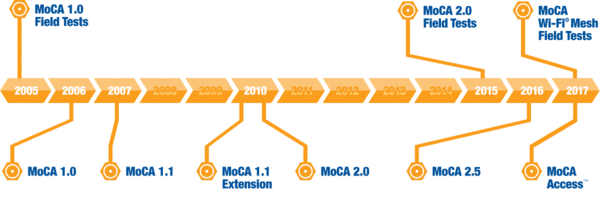Multimedia over Coax Alliance
The Multimedia over Coax Alliance (MoCA) is an international standards consortium publishing specifications for networking over coaxial cable.

There are three versions of the specification currently available, MoCA 1.1, MoCA 2.0, and MoCA 2.5.
History
MoCA was established in 2004.
MoCA 1.0 was approved in 2006, MoCA 1.1 in April 2010, MoCA 2.0 in June 2010, and MoCA 2.5 in April 2016.[1]
Membership
The Alliance currently has 45 members including pay TV operators, OEMs, CE manufacturers and IC vendors.[2]
MoCA’s board of directors consists of Arris, Broadcom, Comcast, Cox Communications, DirecTV, Echostar, Intel, InCoax, MaxLinear and Verizon.
Technology
Within the scope of the Internet protocol suite, MoCA is a protocol that provides the link layer. In the 7-layer OSI model, it provides definitions within the data link layer (layer 2) and the physical layer (layer 1). DLNA approved of MoCA as a layer 2 protocol.[3]

MoCA 1.1
MoCA 1.1 provides 175 Mbit/s net throughputs (275 Mbit/s PHY rate) and operates in the 500 to 1500 MHz frequency range.[4]
MoCA 2.0
MoCA 2.0 offers actual throughputs (MAC rate) up to 1 Gbps. Operating frequency range is 500 to 1650 MHz. Packet error rate is 1 packet error in 100 million.[5]
MoCA 2.0 also offers lower power modes of sleep and standby and is backward interoperable with MoCA 1.1.[6]
In March 2017, SCTE/ISBE society and MoCA consortium began creating a new "standards operational practice" (SCTE 235) to provide MoCA 2.0 with Docsis 3.1 interoperability. Interoperability is necessary because both MoCA 2.0 and Docsis 3.1 may operate in the frequency range above 1 GHz. The standard "addresses the need to prevent degradation or failure of signals due to a shared frequency range above 1 GHz". [7][8]
MoCA 2.5
MoCA 2.5 (introduced April 13, 2016[9]) offers actual data rates up to 2.5 Gbit/s, continues to be backward interoperable with MoCA 2.0 and MoCA 1.1, and adds MoCA protected setup (MPS), Management Proxy, Enhanced Privacy, Network wide Beacon Power, and Bridge detection.[10]
MoCA Access is intended for multiple dwelling units (MDUs) such as hotels, resorts, hospitals, or educational facilities. It is based on the current MoCA 2.0 standard which is capable of 1 Gbps net throughputs, and MoCA 2.5 which is capable of 2.5 Gbps[11].
MoCA performance profiles
| MoCA 1.0 | MoCA 1.1 | MoCA 2.0 | MoCA 2.0 bonded |
MoCA 2.1 | MoCA 2.1 bonded |
MoCA 2.5 | MoCA 3.0 | |
|---|---|---|---|---|---|---|---|---|
| Mbit/s actual throughput | 100 | 175 | 500 | 1000 | 500 | 1000 | 2500 | 10000 |
| Number of channels bonded | 2 | 2 | 3~5 | ≤4 | ||||
| Power save (standby and sleep) | X | X | X | X | X | X | ||
| MoCA protected setup (MPS) | X | X | X | |||||
| Management proxy | X | X | X | |||||
| Enhanced privacy | X | X | X | |||||
| Network wide beacon power | X | X | X | |||||
| Bridge detection | X | X | X |
Frequency band plan
| Channel | Frequency (center), MHz[12] |
|---|---|
| E1 | 500 |
| E2 | 525 |
| E3 | 550 |
| E4 | 575 |
| E5 | 600 |
| A1 | 875 |
| B1 | 900 |
| C1 | 925 |
| C2 | 950 |
| C3 | 975 |
| C4 | 1000 |
| D1 | 1150 |
| D2 | 1200 |
| D3 | 1250 |
| D4 | 1300 |
| D5 | 1350 |
| D6 | 1400 |
| D7 | 1450 |
| D8 | 1500 |
Notes:
- Channel C4 is commonly used for Verizon FiOS for the "WAN" link from the ONT to the router.[13]
- Channels D1-D8 are commonly used for "LAN" links, between set-top boxes and the router.[13]
- E band channels are commonly used by DirecTV converter boxes. The DirecTV Ethernet-to-Coax Adapter (DECA) uses MoCA on this "Mid-RF" frequency band.
See also
- Ethernet over coax
- G.hn
- Home gateway
- HomePlug Powerline Alliance
- Home network
- IEEE 802.3
- IEEE 802.11
- IEEE 1905
- Router (computing)
- Ultra high definition television
- Wireless LAN
- HomePNA
References
- "Home Networking Gets a New Performance Standard". www.mocalliance.org. Retrieved 2016-04-13.
- "MoCA Members". MoCAlliance.org. Retrieved October 16, 2013.
- MOCA FAQs
- http://moca4installers.com/moca_faqs.php
- "Introducing MoCA 2.0". MoCA website. June 15, 2010. Retrieved May 25, 2012.
- "MoCA FAQs". MoCA web site. Retrieved October 17, 2013.
- KMCreative. "SCTE/ISBE Standards, MoCA® Team Up on New Operational Practice for DOCSIS® 3.1-MoCA Interoperability". www.mocalliance.org. Retrieved 2017-03-21.
- "SCTE 235, Operational Practice for the Coexistence of DOCSIS 3.1 Signals and MoCA Signals in the Home Environment" (PDF). Society of Cable Telecommunications Engineers Inc. Retrieved 2017-03-21.
- KMCreative. "Home Networking Gets a New Performance Standard". www.mocalliance.org. Retrieved 2017-01-07.
- "MoCA 2.5 News". MoCA web site. Retrieved May 10, 2016.
- KMCreative. "MoCA Access™". www.mocalliance.org. Retrieved 2017-10-02.
- "MoCA 1.1 Specification for Device RF Characteristics" (PDF). MoCAlliance.org. Multimedia over Coax Alliance.
- Verizon Online FiOS FAQ → 3.2 MOCA